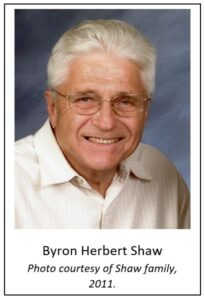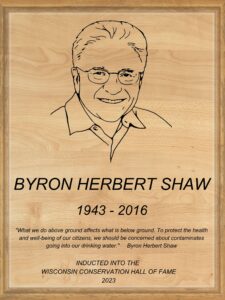1943 – 2016
Inducted 2023
BYRON HERBERT SHAW (1943 – 2016)
 What we do above ground affects what is below ground. To protect the health and well-being of our citizens, we should be concerned about contaminates going into our drinking water.
What we do above ground affects what is below ground. To protect the health and well-being of our citizens, we should be concerned about contaminates going into our drinking water.
–Byron Herbert Shaw
Byron Herbert Shaw is widely known for becoming the first scientist in Wisconsin and among the first in the nation to recognize that pesticides used on farm fields could leach through the soil to contaminate groundwater. As a persistent, perceptive, and courageous water and soils scientist interested in conducting applied research on questions vital to the management of Wisconsin’s natural resources and motivated by strong environmental and civic ethics, Shaw made and communicated new scientific discoveries that influenced policy and law in Wisconsin including Wisconsin’s groundwater protection law, a model for the nation. Few scientists have contributed more to the fundamental body of knowledge about water quality than Byron Shaw.
Byron Shaw was a lifelong resident of Wisconsin. He was born in Madison on January 4, 1943, to Kenneth and Ruth (Wilhelm) Shaw. He grew up in Waunakee. As a young boy, he hunted, fished, and trapped with his father and raised trees for sale. From his youth, he loved the outdoors and developed strong community-minded values. He was Waunakee’s first Eagle Scout.
Shaw earned both his B.S. and M.S. degrees in soil science and a Ph.D. in Soil Science with a minor in Water Chemistry from the University of Wisconsin-Madison. Dr. S.A. Wilde, 1994 Wisconsin Conservation Hall of Fame Inductee, was his mentor. At UW-Madison, he met Margaret, whom he married in June 1966.
In 1968, Dr. Shaw began his career as an assistant professor of Soil and Water Science in the College of Natural Resources at UW-Stevens Point (UWSP). He became a full professor and taught in the College until his retirement in 2000. He established the Environmental Task Force Laboratory (now called the Water and Environmental Analysis Laboratory) to address soil and water quality problems, help train students as water chemists, and bring in grant funds to support student research. He was the major professor for more than 50 graduate students, many of whom helped him make important scientific discoveries through work done in the Environmental Task Force Lab.
In 1980, Shaw documented the presence of aldicarb, a pesticide used on potatoes, in wells in Portage County, thereby becoming among the first in the nation to recognize that pesticides used on farm fields could leach through the soil to contaminate groundwater. He also was the first to find acid rain and acid snow in Wisconsin, and he pioneered one of the first major agricultural watershed and reservoir modeling efforts in the nation on the Big Eau Pleine reservoir in Marathon County. The Eau Pleine research and other research on subdivision effects on groundwater quality led to changes in public policy. His testimony is also credited with contributing to the passage of Wisconsin’s landmark groundwater protection law in 1984.
County, thereby becoming among the first in the nation to recognize that pesticides used on farm fields could leach through the soil to contaminate groundwater. He also was the first to find acid rain and acid snow in Wisconsin, and he pioneered one of the first major agricultural watershed and reservoir modeling efforts in the nation on the Big Eau Pleine reservoir in Marathon County. The Eau Pleine research and other research on subdivision effects on groundwater quality led to changes in public policy. His testimony is also credited with contributing to the passage of Wisconsin’s landmark groundwater protection law in 1984.
In 1977, Dr. Shaw became a Water Resource Specialist with University of Wisconsin-Extension. Like all Extension specialists, he implemented the Wisconsin Idea – the idea that University knowledge, research, and resources should reach to all corners of the state. He loved traveling across Wisconsin to meet with and educate citizens about private well water quality and lake management in their own communities. He improved UWSP’s and UW-Extension’s capabilities to serve the public through the ETF and by helping establish the Central Wisconsin Groundwater Center.
Shaw was a man of many skills and interests beyond being a leading scientist, admired colleague, university professor, and mentor. He was a farmer who loved his farm where he lived with his family near Amherst Junction. In 2000, he transformed 52 acres of the farm to native prairie to provide pollinator habitat and improve water quality. Shaw invited friends and organized groups to tour the farm and learn skills such as prairie burning and soil judging. As a skilled woodworker, he used wood from the farm and elsewhere to build cedar strip canoes, some of which were donated to raise money for environmental causes. He also made wood carvings of birds and other wildlife. In retirement, he continued to work as a Soil and Water consultant for 15 years, testifying in precedent-setting water quality cases in several states.
Byron Shaw received many awards over his long career, including the Wisconsin Idea Award from the College of Agricultural and Life Sciences at UW-Madison, and the first Distinguished Service Award from the Wisconsin chapter of the American Water Resources Association. But he might have considered developing fruitful relationships with the enormous community of conservation professionals and advocates he trained, mentored, and inspired to be his most significant accomplishment.
Resources
Pictures





























